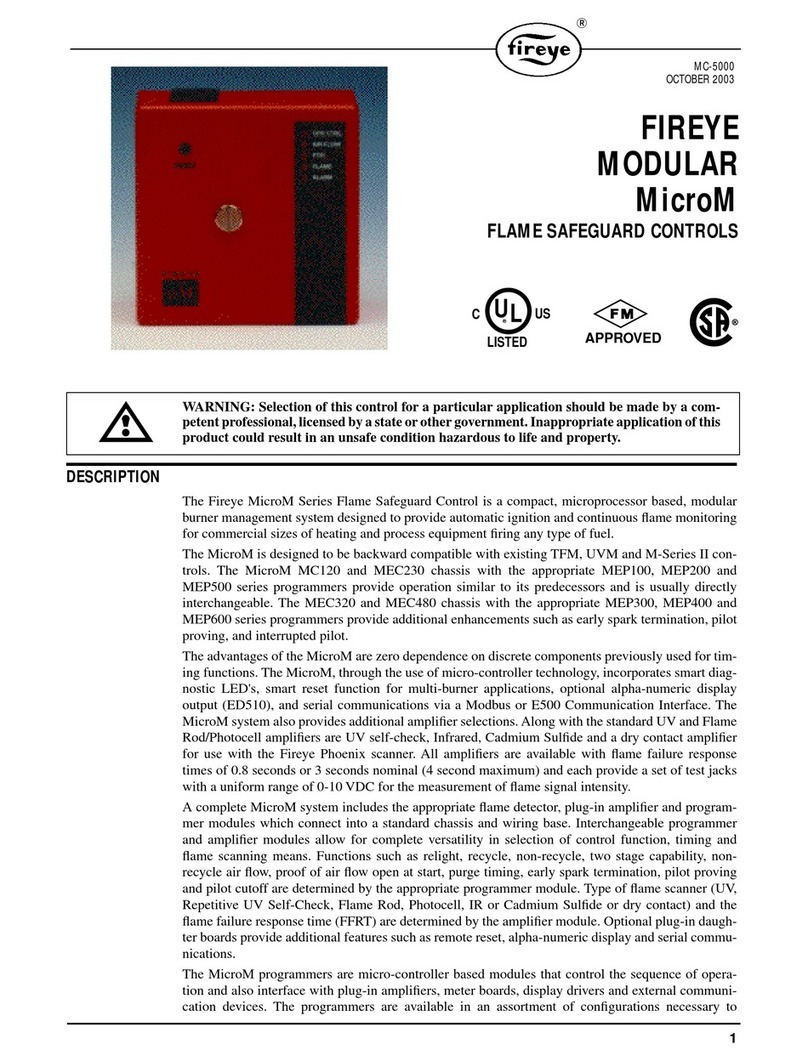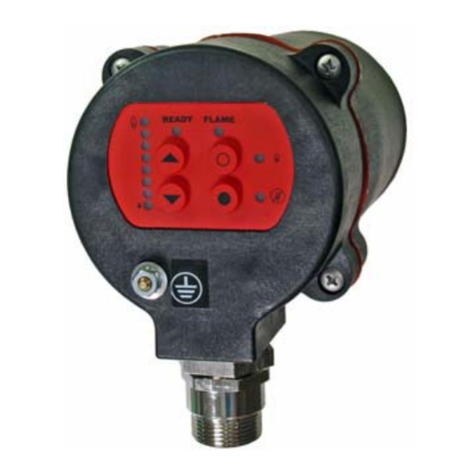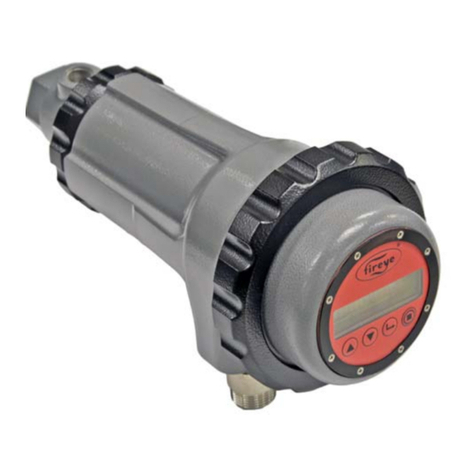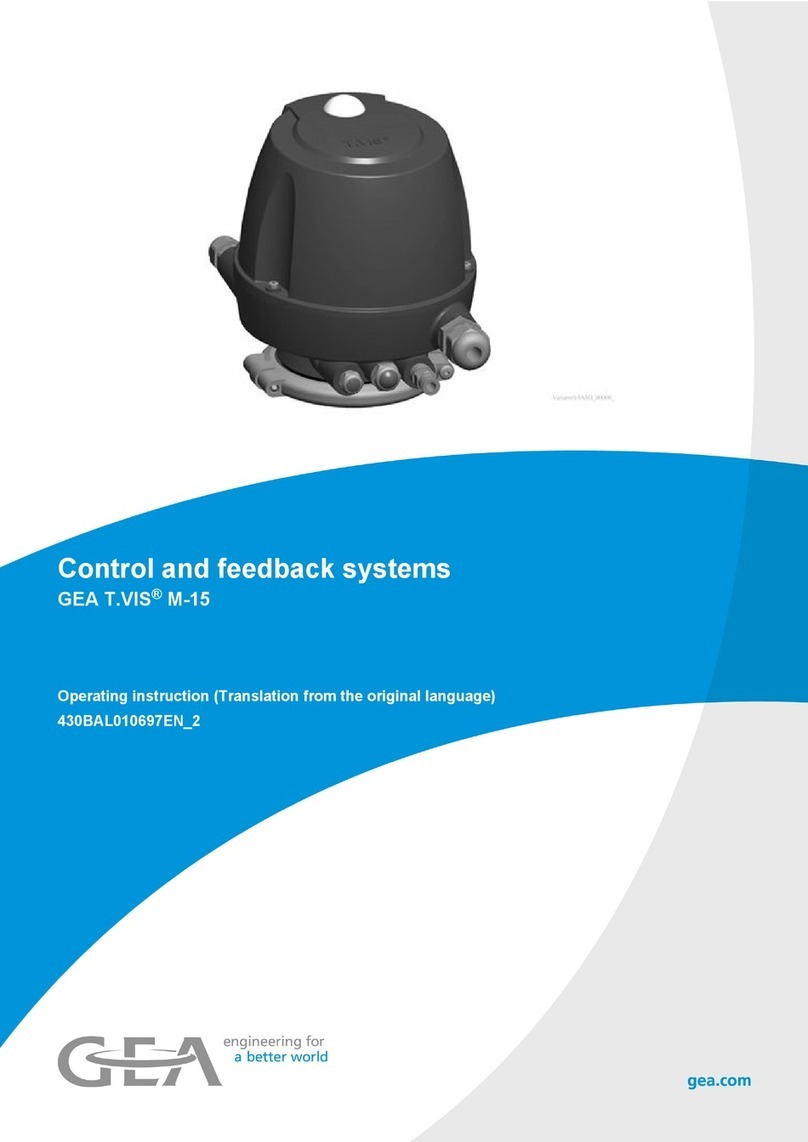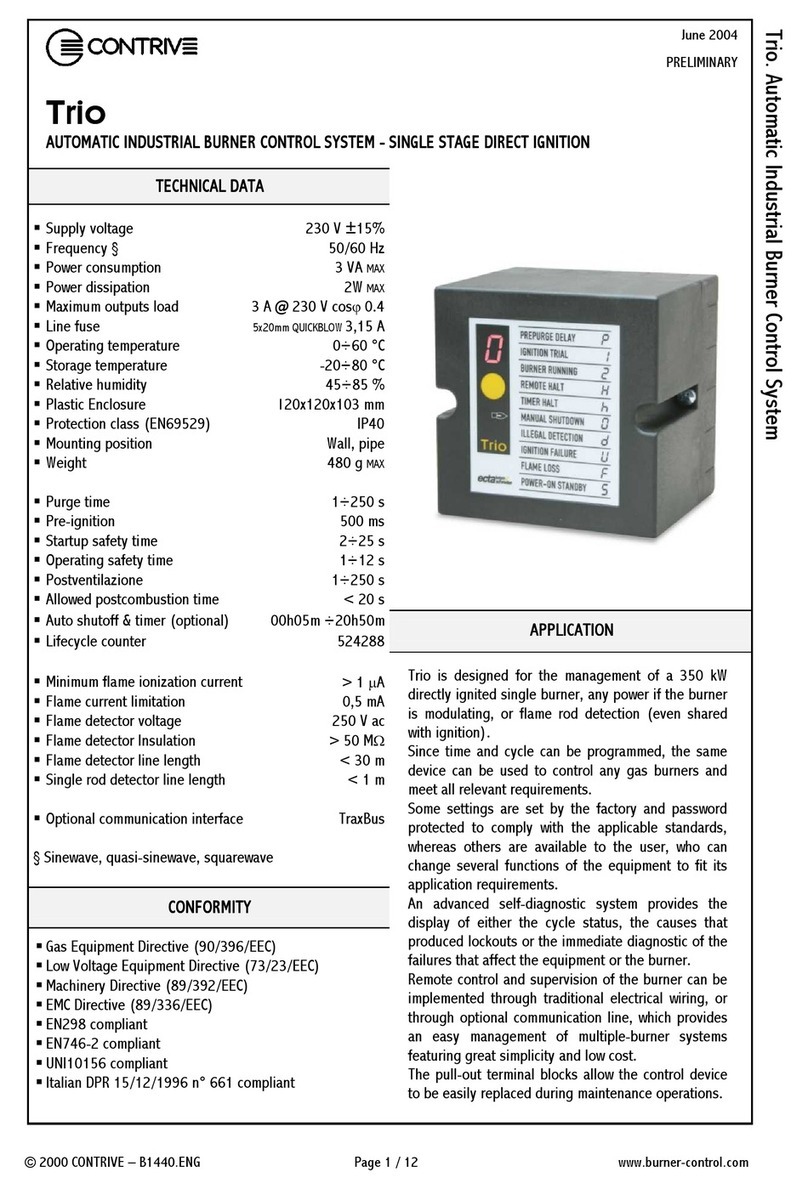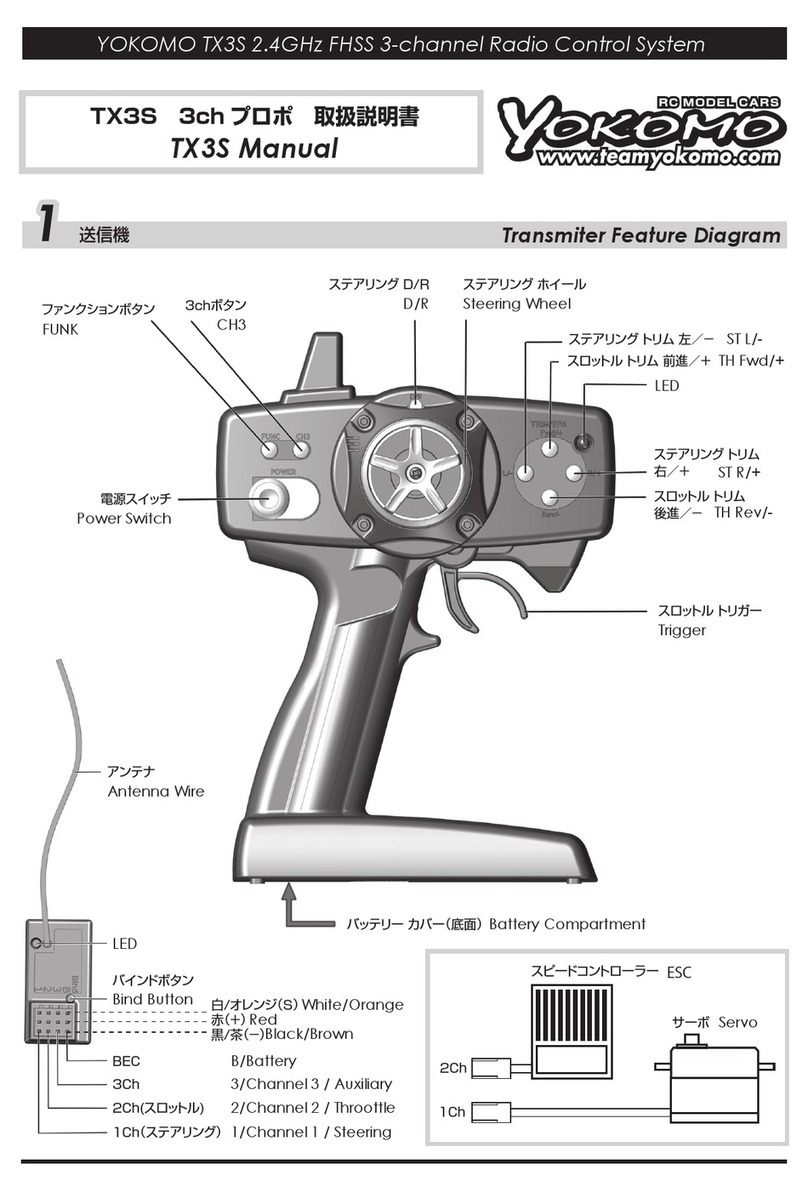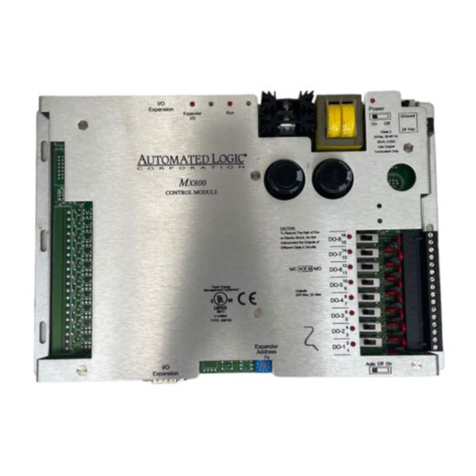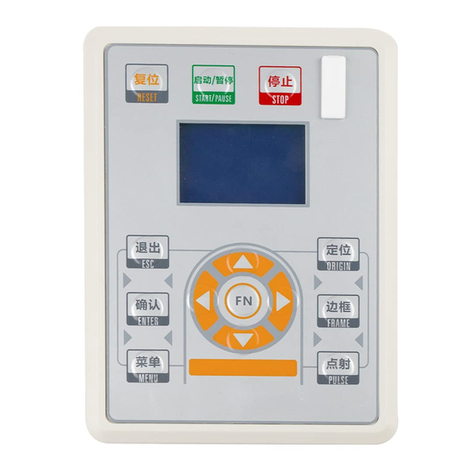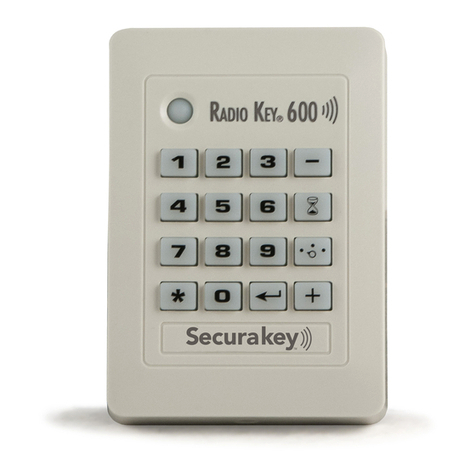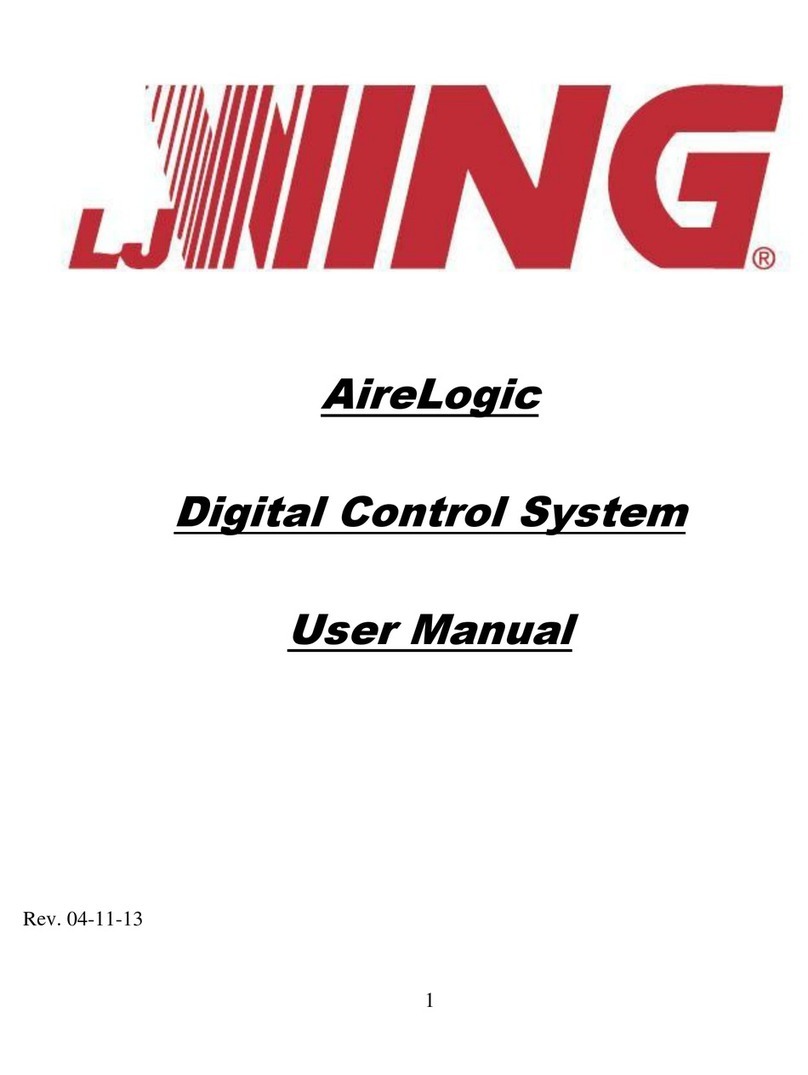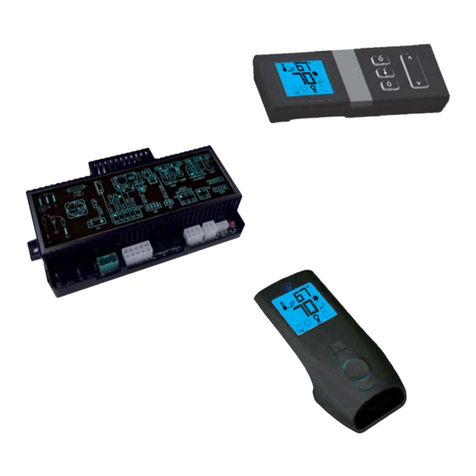Fireye M-SERIES II User manual

1
£
FIREYE
MODULAR
M-SERIES II
FLAME SAFEGUARD CONTROLS
WARNING: Selection of this control for a particular application should be made by a com-
petent professional, licensed by a state or other government agency. Inappropriate application
of this product could result in an unsafe condition hazardous to life and property.
DESCRIPTION
Fireye® Modular M-Series II Flame Safeguard Controls are compact, modular burner management
systems for intermittent operation. They are designed to provide automatic ignition and continuous
flame monitoring for commercial sizes of heating and process burners that use gas and/or light oil
fuels.
Flame monitoring is accomplished by miniature UV scanners or Flame Rod detectors and plug-in
amplifier and programmer modules which connect into a standard chassis and wiring base. Inter-
changeable programmer and amplifier modules allow for complete versatility in selection of control
function, timing, and flame scanning means. Functions such as re-ignition or non-recycle are deter-
mined by the programmer module. Type of flame scanner (UV or Flame Rod) and Flame Failure
Response Time (F.F.R.T.) are determined by the amplifier module.
LED indicator lights on all programmer modules indicate the operating status of the control.
In the event of ignition failure, or following a safety shutdown, the unit locks out, activating an
alarm circuit. Manual reset is required. Remote reset (via remote pushbutton or power interruption)
is available on the MC120RE and MC230R chassis. A detailed description of the various program-
mer modules is found later in this document. Test jacks are provided to permit flame signal measure-
ment during operation.
Modular M-Series II controls incorporate a safety checking circuit that is operative on each start. If
flame (real or simulated) is detected prior to a start or during the purge, the fuel valves will not be
energized, and the unit will lock out.
The Modular M-Series II controls use the same wiring base as the Fireye UVM and TFM Controls
and are designed to be interchangeable with most models without rewiring. See INSTALLATION
OF CONTROL, SCANNERS, AND FLAME DETECTORS for temperature and wiring require-
ments.
C-4000-E
MARCH 22, 2007

2
£
SPECIFICATIONS
Supply:
120 V (min. 102, max. 132) 50/60 Hz. (MC120E and MC120RE)
230V (min. 196, max 253) 50/60Hz (MC230 and MC230R)
Table 1: AMBIENT TEMPERATURE LIMITS
Power Consumption:
12 VA (Operating)
Shipping Weight (Approx.):
5 lbs. (2.3 Kg.)
Table 2: LOAD RATINGS (15 Amps circuit breaker*connected in series between terminal 1 and 7).
MAXIMUM MINIMUM
Control 140qF (60qC) - 40qF(- 40qC)
Scanner UV1A,
UV2, UV8A, 45UV3
200qF (93qC) - 40qF(- 40qC)
Flame Rod
(Tip 2460 F)
1500qF (816qC) - 40qF(- 40qC)
Fireye
Terminal
Typical Load Maximum Rating & 120V 50/60 Hz
or 230V 50/60 Hz.
3 or 4
Individual
or combined
Pilot valve(s)
Solenoid valve
Ignition Transformer
125 VA pilot duty (solenoid valve) plus
250 VA (Transformer)
5Main Fuel Valve(s) 125 VA pilot duty (solenoid) or
25 VA pilot duty (solenoid) and
400 VA (opening) motorized
8Motor or contactor Motor normally energized and de-energized by the operating
control whose rating must be suitable. Terminal 8, for the 120V
series products, is rated to de-energize 9.8 FLA, 58.8 LRA, on
safety lockout, for the 230V series products, is rated to de-
energize 5.2 FLA, 31.2 A LRA, on safety lockout.
AAlarm 50 VA, pilot duty
*Circuit breaker, type standard delay suggested Potter & Brumfield.
#W67-X2Q12-15V or equivalent.
Specification: Single pole, series trip, white toggle.
Max. Line voltage 250 VAC 50/60 Hz.
Current rating 15 Amps.
VDE approved breaker 0642/EN60934.
Insulation resistance: 100 Megohms at 500VDC.
Operating Temperature: -40qC to 85qC.

3
£
OUTLINE DIMENSIONS
ORDERING INFORMATION
CHASSIS (COMMON FOR ALL CONTROLS, INCLUDES DUST COVER):
MC120E 120 VAC Supply, 50 Hz/60 Hz
MC120RE 120 VAC supply, 50 Hz/60 Hz. Remote reset capability.
MC230 230 VAC Supply, 50 Hz/60 Hz
MC230R 230 VAC Supply, 50 Hz/60Hz. Remote reset capability.
PROGRAMMER MODULES:
MP100, MP100ERe-ignition operation, 10 second ignition safety time.
MP102, MP102ENon-Recycle operation, 5 second ignition safety time.
NOTE: Programmers with the suffix "E" (e.g. MP100E) are for use with the MC230 and MC230R
Chassis only.
2
(50.8)
1/2-14 STRAIGHT
FEMALE PIPE THREAD
1” DIA
(25.4)
UV1A UV SCANNER
36” FLEXIBLE CABLE (UV1A3)
72” FLEXIBLE CABLE (UV1A6)
2
(50.8)
36” (1m APPROX.)
FLEXIBLE CABLE
3/8” PIPE THREAD
13/16 DIA.
(206)
UV2 UV SCANNER
2 3/8
(60.3)
1 3/16
(30)
1/2
(12.7)
”L”
1/2-14 NPT
13/16 HEX
(20.6)
15/16 HEX
(23.8)
”L” LENGTH AS SPECIFIED: 12”, 18”, 24” (304.8, 457.2, 609.6)
69ND1 FLAME ROD
5 3/16
5 3/16
MOUNTING BASE
2 1/4”
(57.2mm)
1 1/2”
(38.1mm)
UV8A SCANNER
1/2 X 14 ST.
PIPE
THREAD
1 IN. DIA.
(25.4mm)
SHIELDING OF 6 FT. (1830mm)
LEADS IS REQUIRED
.700 DIA. FITTING (17.8mm)
FOR WATER-TIGHT CONDUIT
5 5/16
4
41/2
1/2
3/16” DIA. MOUNTING
HOLES (4)
KNOCKOUTS (12)
FOR 1/2”
CONDUIT
HOLE FOR
3/4”
SIGHTING
PIPE
SCREW
1/4-20 THD
2 7/8”
(73)
2”
(50.8)
1 5/8”
(41)
3 1/4”
(82)
S1
7
S2
3
2/N
5
A
4
6
1
1.48"
(37.6mm)
UV SCANNER
TYPE 45UV3
MODEL 1050

4
£
AMPLIFIER MODULES: USE WITH SCANNERS:
MAUV3 UV amplifier, 3 second F.F.R.T. UV1A, UV2, UV8A, 45UV3-1050
MAUV1T UV amplifier, 1 second F.F.R.T. UV1A, UV2, UV8A, 45UV3-1050
MART3 Flame rectification amplifier, 69ND1
3 second F.F.R.T.
MART1T Flame rectification amplifier, 69ND1
1 second F.F.R.T.
UV SCANNERS:
UV1A3 1/2” NPT connector, 3’ (914mm) flex. cable
UV1A6 1/2” NPT connector, 6’ (1829mm) flex. cable
UV2 3/8” NPT connector, 3’ (914mm) flex. cable
UV8A 1/2” NPT 90 degree angle head, 6’ (1829mm) flex. cable
45UV3-10503/4” sleeve/setscrew mount
FLAME DETECTORS:
69ND1-1000K4 12 inch (304.8mm) flame rod, 1/2” NPT connector
69ND1-1000K6 18 inch (457.2mm) flame rod, 1/2” NPT connector
69ND1-1000K8 24 inch (609.6mm) flame rod, 1/2” NPT connector
WIRING BASE (COMMON FOR ALL CONTROLS):
61-3060 Closed wiring base, surface mounting
61-5042 Open wiring base, cabinet mounting
For a complete system, choose one of each of the following:
— Chassis — UV Scanner or Flame Detector
— Programmer Module — Wiring Base
— Amplifier Module
WARNING: Installer must be trained and qualified. Follow the burner manufacturer’s
instructions, if supplied. Otherwise, proceed as follows:
INSTALLATION OF CONTROL, SCANNERS, AND FLAME DETECTORS
Wiring Base
Mount the wiring base on the burner or on a panel. The location should be free from excessive vibra-
tion and within the specified ambient temperature rating. The base may be mounted in any angular
position.
All wiring should comply with applicable electrical codes, regulations, and local ordinances. Use
moisture resistant wire suitable for at least 90 degrees C. Circuit recommendations are found on
Pages 14 through 15. Consult the factory for assistance with non-standard applications.
WARNING: Controls require safety limits utilizing isolated mechanical contacts. Solid state
limit switches are not acceptable and should not be used due to their high leakage currents.
Installing the Programmer and Amplifier Modules
WARNING: Remove power from the control before proceeding.

5
£
Select the appropriate programmer and amplifier modules for your application. Remove the dust
cover from the chassis. Insert the amplifier module into the slot in the center of the chassis and gen-
tly push the module into position. Insert the programmer module into the slot at the right side of the
chassis and gently push the module into position.
WARNING: Turn off the power when installing or removing the control.
INSTALLATION - UV SCANNERS
Where possible, obtain the burner manufacturer’s instructions for mounting the scanner. This infor-
mation is available for most standard burners. The scanner mounting should comply with the follow-
ing general instructions:
1. Locate the scanner within 30 inches (76cm) of the flame to be monitored, closer if possible.
2. Select a scanner location that will remain within the ambient temperature limits of the UV-eye
scanner (200qF/93qC). If cooling is required, use (a) an insulating coupling (Fireye part #35-69)
to reduce conducted heat; (b) a window coupling (Fireye part #60-1257) to seal off furnace or
burner pressure; (c) cooling air to reduce the scanner sight pipe temperature.
3. Mount rigidly a short length (10-20cm) of 1/2sor 3/4sblack iron pipe in a position that permits
an unobstructed view of the pilot and/or main flame.
CAUTION: The scanner must not sight the ignition spark directly, or any part of the burner
that can reflect the spark back to the scanner.
4. The maximum UV signal from a flame is found in the first one-third of the visible flame taken
from the point where the flame begins. The scanner sight pipe should be aimed at this area.
5. A correct scanner application will not see a pilot flame that is too small to ignite the main flame
reliably. Note particularly the test for minimum pilot that is described on Page 12.
6. On installations having negative pressure combustion chambers, a small hole (1/8sor 3/16s)(3 or
5mm)drilled in the sight pipe will assist in keeping the pipe clean and free from smoke.
7. Two scanners may be installed on one burner if it is necessary to view two areas to obtain reli-
able detection of the flame. They should be wired in parallel.
AMPLIFIER PROGRAMMER

6
£
8. The UV-eye scanner is designed to seal off the sight pipe up to pressures of 1 PSI (.07kg/cm2)
when the scanner lock nut is firmly tightened. Pressures in excess of 1 PSI (.07kg/cm2) should
be blocked from the scanner. A quartz lens coupling (Part #60-1290) or quartz window coupling
(Part #60-1257) may be used. Each is rated from -3 to +100 PSI max. (-.2kg/cm2to +7kg/cm2
max.).
9. To increase scanner sensitivity, a quartz lens coupling (Part #60-1290) may be used. The quartz
lens permits location of the UV-eye twice the distance noted in Item 1. Use 1/2sx11/2snipple
between UV1A scanner and union. Use 3/8sclose nipple and 1/2sby 3/8sbushing on UV-2 appli-
cations.
General Requirements
1. As close as possible — 30s(76cm)or closer.
2. As cool as possible — Not over 200qF/93qC.
3. Avoid sighting the spark — Resight scanner, shield between spark and scanner, or orifice to
reduce reflected signal from spark.
4. Must see pilot and/or main flame — Scanner view must be unobstructed,
5. Minimum pilot test — See Page 12.
Typical Scanner Installations
Wiring of UV Scanners
The UV1A scanner is supplied with 3' (90cm) or 6' (180cm) of flexible cable. The UV-2 scanner is
supplied with 3' (90cm) of flexible cable. If it is necessary to extend the scanner leads, the following
instructions apply:
1. Scanners without armored cable must be wired using metal cable or rigid conduit.
2. High voltage wiring must not be installed in the same conduit with flame detector wiring.
3. Selection of Scanner Wire:
a. Use #14, 16, or 18 gauge wire with 90qC, 600 volt insulation for up to 200 feet (60M)of
distance. (approx. 20% signal loss at 100 feet [30M], 40% signal loss at 200 feet [60M]).
b. Asbestos insulated wire should not be used.
c. Multi-conductor cable is not recommended without prior factory approval.
d. High voltage ignition wiring should not be installed in the same conduit with flame detector
wires.
The maximum UV signal
from a flame is found in
the first one-third of the
visible flame taken from
the point where the flame
begins. The scanner sight
pipe should be aimed at
this area.
SCANNER
METHODS OF COOLING SCANNER
INSULATING
TUBING
SEALING UNION
FORCED
AIR
EXTEND SIGHTING TUBE
6”(152mm) OR 8”(203mm)
DO NOT EXTEND MORE THAN
HALF-WAY INTO REFRACTORY

7
£
4. Installation of Extended Scanner Wiring:
— For extended scanner wiring up to 500 feet (150M), and for shorter lengths to reduce signal
loss, use a shielded wire (Belden 8254-RG62 coaxial cable, or equal) for each scanner wire
of UV1, UV2. The ends of the shielding must be taped and not grounded.
5. Multiple Scanner Installations:
— The wiring from multiple UV scanners may be installed in a common metallic conduit.
— Multi-conductor cable is not recommended without prior factory approval.
INSTALLATION - 69ND1 FLAME ROD
The 69ND1 flame rod proves a gas pilot flame and/or main gas flame. It is a spark plug type unit
consisting of 1/2sNPT mount, a KANTHAL flame rod, a glazed porcelain insulating rod holder and
a spark plug connector for making electrical connections. The 69ND1 is available in 12s(304.8mm),
18s(457.2mm) or 24s(609.2mm) lengths.
The flame rod may be located to monitor only the gas pilot flame or both the gas pilot and main gas
flames. It is mounted on a 1/2sNPT coupling.
The following instructions should be observed:
1. Keep flame rod as short as possible.
2. Keep flame rod at least 1/2s(12.7mm)from any refractory.
3. Flame rod should enter the pilot flame from the side so as to safely prove an adequate pilot
flame under all draft conditions.
4. If the flame is nonluminous (air and gas mixed before burning), the electrode tip should extend
at least 1/2s(12.7mm)into the flame, but not more than halfway through
5. If the flame is partly luminous, the electrode tip should extend only to the edge of the flame. It is
not necessary to maintain absolutely uninterrupted contact with the flame.
6. It is preferable to angle the rod downward to minimize the effect of sagging and to prevent it
from coming in contact with any object.
7. An adequate grounding surface for the flame must be provided. The grounding surface in actual
contact with the flame must be at least four times greater than the area of the portion of the
flame rod in contact with the flame. It is essential to adjust the flame rod and ground area ratio
to provide a minimum signal reading of 6VDC.
Note: Interference from the ignition spark can alter the true signal reading by adding to, or sub-
tracting from it. This trend sometimes may be reversed by interchanging the primary wires (line volt-
age) to the ignition transformer. This interference can also be reduced by the addition of grounded
shielding between the flame rod and ignition spark.
WRONG POSITION
OF ROD
INADEQUATE FLAME
PILOT BURNER
CORRECT POSITION
OF PILOT FLAME
CORRECT
POSITION
OF ROD

8
£
8. Proven types of flame grounding adapters, as shown below, may be used to provide adequate
grounding surface. High temperature stainless steel should be used to minimize the effect of
metal oxidation. This assembly may be welded directly over the pilot or main burner nozzle
WIRING OF FLAME RODS
For proper operation of flame rectification systems (flame rods), it is necessary to maintain at least
20 megohms insulating resistance in the flame rectification circuit.
1. The scanner should be wired using metal cable or rigid conduit.
2. High voltage wiring must not be installed in the same conduit with scanner wiring.
Selection of Scanner Wire
1. Use #14, 16, or 18 gauge wire with 90qC, 600 volt insulation for up to 100 feet (30M) distance.
2. The type of insulation used with flame rectification wiring is important, since it must protect
against current leakage resistance to ground. Use Belden 8254-RG62 Coaxial Cable (or equal)
for runs greater than 100 feet (30M). Maximum wiring run not to exceed 400 feet (120M).
MAINTENANCE
Type UV1, UV2, UV8A, and 45UV3 Ultraviolet Scanners
The viewing area of the scanner must be kept clean. Even a small amount of contamination will
reduce the flame signal reaching the detector by a measurable amount. Wipe the viewing area rou-
tinely using a soft cloth dampened with concentrated detergent.
Type 69ND1 Flame Rod
The flame rod and its insulator should be kept clean by washing routinely with soap and water. Rods
should be routinely replaced as they oxidize.
Flame Signal Strength
Routine observation of the flame signal strength will forewarn any deterioration in the capability of
the flame detector or its application.
Periodic Safety Check
It is recommended that a procedure be established to test the complete flame safeguard system at
least once a month. This test should verify the proper operation of all limit switches and safety inter-
locks as well as flame failure protection and fuel safety shutoff valve tightness.
Rotation
It is recommended that control and scanner units purchased as spares be installed periodically.
BOMB FIN
GROUNDING
ASSEMBLY
THREADED ROD
ASSEMBLY

9
£
MC120E REMOTE RESET CHASSIS
The MC120RE and MC230R Chassis provides remote reset capabilities in the event of a lockout
condition. The remote reset chassis can be reset in any of the following ways:
1. Depress and release the reset button built into the chassis. This reset button will always reset the
control.
2. To reset the control via a remote pushbutton. Wire a momentary dry contact pushbutton into the
two (2) terminals located on the chassis (on the same PC board as the built-in reset switch) and
depress the button for one (1) second. The maximum distance the remote reset switch can be
wired from the control is 1,000 feet (300M).
CAUTION: Remote reset is recommended only on a control solely for proved ignition pro-
gramming (pilot ignited burner) or a control for use only with appliances in which unburned
fuel cannot accumulate and that is intended for installation in inaccessible locations such as
open-flame, ceiling-suspended gas heaters.
LED INDICATOR LIGHTS
The Programmer Modules have 5 LED lights to indicate the operating status of the control. The
function of these lights are:
Operating Control: This LED is energized whenever the burner control switch (Terminal #7) along
with the various limit switches, operating controls and fuel interlocks are closed.
Air Flow: This LED is energized whenever the air flow switch is closed between Terminals #8 and
#6, and power is on Terminal #8.
PTFI: This LED is energized only during the Ignition Safety Time.
Flame On: This LED is energized whenever a flame signal is detected by the UV scanner or Flame
detector.
Alarm: this LED is energized whenever a safety lockout occurs. (See APPLICATION AND FUNC-
TION section).
APPLICATION AND FUNCTION - MP100, MP100E
The MP100 and MP100E Programmer Modules are designed as a replacement for the Fireye M1
Series “re-ignition” controls. It provides ignition and Flame Safeguard for heating or process light
oil or gas fired burners. The Amplifier Module should be selected based on the type of flame scanner
(UV scanner, or flame rod), and the required Flame Failure Response Time (F.F.R.T.). See ORDER-
ING INFORMATION on Page 4 for the appropriate part numbers.
Pilot Ignited Burners
The typical wiring arrangement illustrated on Page 16 for pilot ignited burners provides the follow-
ing function:
1. With power applied, and the limit-operating control circuit closed (Operating Control LED
lit), the burner motor circuit is energized. The air flow switch circuit closes (Air Flow LED lit).
2. Following a short-time delay (4 to 6 sec.), KL-1 closes, energizing Terminal 3 which powers the
pilot gas valve, and Terminal 4 which powers the spark ignition. A 10 sec. trial for ignition is
initiated (PTFI LED lit).
3. When pilot flame is detected (Flame LED lit), KF-1 closes, energizing Terminal 5 which pow-
ers the main fuel valve, and KF-2 opens, de-energizing Terminal 4 which shuts off the spark
ignition.
4. When the operating control opens its circuit, or if a power failure occurs, the control is de-ener-
gized. When power is restored, the control will restart.

10
£
NOTE: Controls with UV amplifiers (MAUV3 and MAUV1T) are always powered via Terminal #1.
5. In the event the pilot flame is not detected by the end of the trial for ignition period, the pilot gas
valve and spark ignition are de-energized. A safety lockout occurs which de-energizes the
burner motor and energizes the lockout alarm circuit (Alarm LED lit) approximately 10 to 30
seconds after the safety shutdown occurs.
6. In the event of a flame failure during a firing period, the main fuel valve is de-energized and the
spark ignition re-energized. A 10 sec. trial for ignition is initiated (PTFI LED lit). If flame is
detected (Flame LED lit) during the trial for ignition period, the main fuel valve is re-energized
and the spark ignition de-energized. If flame is not detected during the trial for ignition period,
the pilot gas valve and spark ignition are de-energized. A safety lockout occurs which de-ener-
gizes the burner motor and energizes the lockout alarm circuit (Alarm LED lit) approximately
10 seconds after the safety shutdown occurs.
7. Manual reset is required following any safety lockout.
NOTE: Wait 10 seconds after lockout before resetting the control.
Direct Spark Ignited Burners
The typical wiring arrangement illustrated on Page 16 for direct spark ignited burners provides the
following function:
1. With power applied, and the limit-operating control circuit closed (Operating Control LED lit),
the burner motor circuit is energized. The air flow switch circuit closes (Air Flow LED lit).
2. Following a short-time delay (4-6 sec.) KL-1 closes, energizing Terminal 3 which powers the
primary main fuel valve and Terminal 4 which powers the spark ignition. A 10 sec. Trial for
ignition is initiated (PTFI LED lit).
3. When main flame is detected (Flame LED lit), KF-1 closes, energizing Terminal 5 which pow-
ers the secondary main fuel valve (if used), KF-2 opens de-energizing Terminal 4 which shuts
off the spark ignition.
4. When the operating control opens or if a power failure occurs, the control is de-energized. When
power is restored, the control will restart.
NOTE: Controls with UV amplifiers (MAUV3 and MAUV1T) are always powered via Terminal #1.
5. In the event that main flame is not detected by the end of the trial for ignition period, the primary
main fuel valve and the spark ignition are de-energized. A safety lockout occurs which de-ener-
gizes the burner motor and energizes the lockout alarm circuit (Alarm LED lit) approximately
10 to 30 seconds after the safety shutdown occurs.
6. In the event of a flame failure during a firing period, the secondary main fuel valve (if used) is
de-energized and the spark ignition is re-energized. A 10 sec. trial for ignition is initiated (PTFI
LED lit). If flame is detected (Flame LED lit), the secondary main fuel valve (if used) is re-
energized and the spark ignition de-energized. If flame is not detected during the trial for igni-
tion period, the primary main fuel valve and the spark ignition are de-energized. A safety lock-
out occurs, which de-energizes the burner motor and energizes the lockout alarm circuit (Alarm
LED lit) approximately 10 to 30 seconds after the safety shutdown occurs.
7. Manual reset is required following and safety lockout.
NOTE: Wait 10 seconds after lockout before resetting the control.
APPLICATION AND FUNCTION - MP102 and MP102E
The MP102 and MP102E operates in the same manner as the MP100 and MP100E with the follow-
ing exceptions. The standing pilot and re-ignition features have been eliminated. The ignition safety
time has been changed to 5 seconds and the control will lockout on flame failure.

11
£
INSTALLATION TESTING
Use of Test Meter (All Controls)
Testing the Fireye Modular M-Series II Controls requires the use of a test AC-DC multimeter, with a
1,000 ohm/volt DC rating or greater, or a digital meter with 500K input impedance or greater.
With the test meter on the DC scale, and the test meter leads inserted into the test jacks on the ampli-
fier module, a steady DC voltage reading of 4.0 to 6.0 volts (for UV amplifiers) and 6 to 18 volts
(for flame rectification amplifiers) should be obtained when the controls are detecting flame, and
zero volts when no flame is present.
With the test meter on the AC scale, line and load voltages may be measured at the identified test
points on the chassis.
On the Modular M-Series II controls utilizing a flame rectification amplifier, a micro-ammeter may
be connected in series with the wire to Terminal S2. Normal flame will produce a meter reading
between 4 and 10 micro-amps.
Flame Signal Testing (All Controls)
1. Manually shut off the main fuel valve for a pilot ignited burner, or the secondary fuel valve for a
direct spark ignited burner.
2. Set the test meter on the DC scale and insert the test leads into the test jacks on the amplifier
module. (If the meter reads backwards, reverse the meter leads). Red - Plus, Black - Negative.
3. Initiate a normal startup.
4. When flame is established, the test reading should be normal: a steady DC voltage reading of
4.0 to 6.0 volts (for UV amplifiers) and 6 to 18 volts (for flame rectification amplifiers).
5. Inadequate flame signal may be improved by:
a. Assuring that the flame detector and wiring installations have followed the instructions on
Pages 5 through 9.
b Assuring that the flame detector is clean and within the ambient temperature limits.
c Assuring that the flame is sufficiently large to detect.
d Assuring that the flame quality (fuel to air ratio, combustion air velocity) is satisfactory.
e Trying a shorter sight pipe, or increasing the sight pipe diameter.
WARNING: Before making a pilot flame test, manually shut off the fuel supply to the main
burner.
Normal Pilot Flame Test
1. Turn power on and initiate a normal startup.
2. Observe the pilot flame signal on the test meter. If the average flame is below normal, a steady
DC voltage reading of 4.0 to 6.0 volts (for UV amplifiers) and 6 to 18 volts (for flame rectifica-
tion amplifiers), re-adjust the pilot flame or realign the flame detector.
WARNING: DO NOT TOUCH a flame rectification rod with power applied
.
3. During the pilot flame test and adjustment period, if flame is not detected within 10 seconds, the
control will lock out. To reestablish the pilot flame trial for ignition (P.T.F.I.), manual reset of
the lockout switch is required, and a complete repurge is accomplished.
4. When UV detection is used, a test is required to verify that UV radiation from the ignition spark
is not being detected. To accomplish this, manually shut off both pilot and main fuels. Initiate a
normal startup, observe the test meter which should read no more than 1/2 volt DC. If more than
1/2 volt DC is observed, realign the UV scanner, and/or shield the spark from the scanner’s
view.

12
£
WARNING: The minimum pilot test must be accomplished by a trained and qualified burner
technician.
Minimum Pilot Test
This test insures that the flame detector will not sense a pilot flame too small to light the main flame
reliably. It must be made on every new installation as well as following the repositioning of the flame
detector. This procedure should not be used on a direct spark ignited burner.
1. Manually shut off the fuel to the main burner.
2. Connect a test meter to the test jacks on the Amplifier Module.
3. Initiate a normal startup.
4. Reduce the fuel to the pilot until the DC voltmeter reads 3.5 volts for UV scanners. See WARN-
ING below. This is the minimum pilot. For flame rectification the flame signal for minimum
pilot varies depending on the application. See WARNING below.
5. Slowly turn on the main fuel and insure that the main flame lights off promptly and normally.
WARNING: If light off is delayed, shut off the power to the installation. Realign the flame
detector so that pilot flame detection requires a larger pilot flame. Repeat this test until the
main flame lights reliably with minimum pilot.
6. After the minimum pilot test is completed satisfactorily, increase the pilot flame to normal size,
and observe that the main flame is properly established during a normal cycle.
Flame Failure Test
1. Temporarily connect spark ignition and pilot valve to Terminal #3.
2. Initiate a normal startup.
3. Manually shut off all fuel and observe the loss of flame signal on the test meter.
4. If flame signal does not reduce to zero within the flame failure response time of the control
(F.F.R.T. determined by selection of amplifier), verify that the UV flame detector is not actuated
by the spark. If spark is detected, a metallic shield or relocation of the UV detector sight pipe is
required.
5. IMPORTANT: When the test is completed, reconnect the spark ignition to Terminal #4.
Recommendation
Periodic Safety Check: Test the complete flame safeguard system at least once a month. This test
should verify flame failure safety shutdown and positive fuel cutoff when the fuel valve is de-ener-
gized.
Replaceable Fuse
The programmer modules are designed with a field replaceable fuse. The fuse is located on the
printed circuit board near the connectors. In the event the fuse becomes shorted, the Operating Con-
trol, Air Flow, and PTFI LED’s will light. However, KL or KF (see WIRING ARRANGEMENTS -
later in this document) will not be energized and the control will lock out. The fuse will blow as a
result of an overload condition on Terminals 3, 4, or 5. To replace the fuse, remove the fuse (using a
small screwdriver) and install a Fireye replacement fuse (P/N 23-176) or equivalent 2AG, 8 amp fuse
Type Fast-Acting (e.g. Little Fuse #225008).
Order Fireye replacement fuse P/N 23-183 or equivalent (3.5 amp fuse 2AG Type SLO-BLO) for
programmer modules used with the MC230 and MC230R chassis (e.g. Little Fuse #22903.5).

13
£
MAINTENANCE
UV-eye scanner: The UV tube must be kept clean. Use a clean cloth with detergent as often as oper-
ating conditions require. Remove any residual detergent.
ROTATION
It is recommended that units purchased as spares be rotated periodically, so that each unit will be
placed in operation every 90 days.

14
£
MAKE
PROPER
BURNER
ADJUSTMENT
DID
OPERATE
CONTROL LED
COME
ON?
DID
PTFI LED
COME ON AFTER
SUITABLE
DELAY?
DID
AIR FLOW
LED
COME
O.C.
ON
ALARM ON
NO HEAT
INSTALL DC VOLTMETER
IN TEST JACKS
SHUT FUEL
SUPPLY COCK
WAIT
5
MIN
RESET CONTROL
PROGRAMMER OR
MC120 DEFECTIVE
MAKE IT
CALL FOR HEAT
SEE SITUATION
SEE SITUATION
CLOSE WINDOW
AND REPEAT
SITUATION #1
IS
HEAT
BEING
CALLED
FOR?
ON?
IS
PROGRAM.
WINDOW
CLOSED?
#3
#2
YES
YES
YES
YES
NO
SITUATION #1
NO
NO
NO
NO
YES
YES
YES
YES
DID PTFI
IS
SYSTEM
RUNNING?
ALIGN
SCANNER
REPAIR
WIRING
SUCCESSFUL
RESET
REPLACE
PROGRAMMER
DID
FLAME
LED COME
ON?
YES
MP100 4-7 SECONDS
MP230 PREPURGE DELAY TIME
NO YES
NORMAL LOCKOUT
NO
NO
NO
NO
NO
YES
AMPLIFIER
DEFECTIVE
OR MC120 REPLACE SCANNER
REPEAT
SITUATION #1
LED GO OFF
AFTER SUITABLE
DELAY?
M-SERIES II
SERVICE GUIDE
TO RESET THE CONTROL
POWER MUST BE ON. (L1-L2)
IS
THERE A
GOOD
FIRE?
IS
PROPER
ACROSS
S1 & S2
VOLTAGE
IS
WIRING &
TERM. CONTACT
PRESSURE
OK?
S1 S2
IS
SCANNER
POSITION
OK?
PROPER
PILOT VOLTAGE
(120V) ACROSS
3, 2
YES
PROPER
IGNITION
VOLTAGE (120V)
ACROSS
4, 2
YES
PROPER
MAIN VALVE
VOLTAGE (120V)
ACROSS
5, 2
YES
CHECK FUSE IN
PROGRAMMER.
NO
CHECK OUTPUT
YES
WIRING
CHECK FUSE IN
PROGRAMMER.
NO
CHECK FUSE IN
PROGRAMMER.
NO
CHECK OUTPUT
YES
WIRING
CHECK OUTPUT
YES
WIRING

15
£
O.C. ON
NO
YES
IS
PRESENT
8-2?
O.C. ON
ALARM ON
YES
REPLACE
MC120
PROGRAMMER
OR
MC120 DEFECTIVE
CHECK BLOWER
SYSTEM
CHECK AIR FLOW
SWITCH AND
CHECK WIRING
IS
BLOWER
ON?
IS
120 VAC
PRESENT
6-2?
FLAME ON
YES
YES
NO
NO
SITUATION #2 SITUATION #3 SITUATION #4
NO HEAT NO HEAT
NO YES
REPLACE FUSE
OR
RESET BREAKER
CHECK
SYSTEM
WIRING
NO YES
REPLACE
MC120
CORRECT
AMPLIFIER
PIN PROBLEM
IS FUSE
OK AND CKT
BREAKER
MADE?
NO
LED’s
ON
YES
NO
NO HEAT
IS
120VAC
PRESENT 120VAC
AMP.
OR PRO.
PINS
ENGAGED
1-2 OR
OR
PROGRAMMER
PINS
7-2?
REMOVE
SCANNER
REPLACE
AMPLIFIER
NO
YES
NO
SEE
SITUATION #1
REPLACE
AMPLIFIER
PROGRAMMER OR
DEFECTIVEMC120
SEE
SITUATION #1
PROGRAMMER OR
DEFECTIVEMC120 REPLACE
SCANNER
SEE
SITUATION #1
NO
YES
NO
YES
CHECK BURNER
WIRING AND FUEL
VALVES. FLAME SHOULD
NOT BE THERE.
IS
FLAME LED
ON?
IS
THIS A UV
SYSTEM?
IS
FLAME LED
ON?
YES
IS
FLAME LED
ON?
IS
FLAME PRESENT
IN BURNER?
NO
TROUBLESHOOTING TIPS
1. Verify that there is a solid earth ground wire brought to the panel that the Fireye base is mounted to.
2. In a rectification system, verify that terminal S1 is solidly earth grounded, and confirm that the flame rod is aligned so it
doesn’t droop near the ignition spark.
3. Confirm that there is no measurable voltage present between the ground screw and terminal 2 (neutral).
4. Confirm that the 120 volt AC supply has its neutral leg earth grounded at the supply, (floating isolation transformers can
cause problems).
5. Confirm that the ignition transformer’s secondary winding is solidly earth grounded. The grounding method is usually
through the transformer case. Dirt, paint, loose mounting hardware, etc., can all be factors.
6. There may be a problem with transients in the main power supply. If you think this may be the problem, you may want to
run a ground wire directly from the pilot assembly back to the electrical panel where the Fireye control is mounted.
M-Series Fuse 2AG 8 amps.
Fireye Part Number: 23-176
or
Little Fuse Number: 225008

16
£
FIGURE 1. TYPICAL MP100, MP100E, MP102, and MP102E WIRING ARRANGEMENT FOR PILOT IGNITED BURNER
Use moisture resistant wire suitable for at least 90qC.
CAUTION: When powered, 560 VAC across S1, S2 with MAUV3 and MAUV1T; 260 VAC
across S1, S2 with MART3 and MART1T.
FIGURE 2. TYPICAL MP100, MP100E, MP102, and MP102E WIRING ARRANGEMENT FOR DIRECT SPARK IGNITED BURNER
Use moisture resistant wire suitable for at least 90qC.
CAUTION: When powered, 560 VAC across S1, S2 with MAUV3 and MAUV1T; 260 VAC
across S1, S2 with MART3 and MART1T.
TERMINAL #1 MUST BE DIRECTLY POW-
ERED AS SHOWN WHEN USING MAUV3 OR
MAUV1T AMPLIFIER MODULES IN ORDER
TO INITIATE SAFETY CHECKING CIRCUIT
OF UV SCANNERS.
LIMIT
SWITCHES
OPERATING
CONTROL
FUEL
INTERLOCKS
7
BURNER MOTOR
OR
CONTACTOR 8
2
A
6
LOCKOUT
ALARM
KB
KA
AIR FLOW
SWITCH
ELECTRONIC
CIRCUIT
KL KF
S1
S2
3
5
4
1
FLAME
AMPLIFIER
KL-1
KF-1
KF-2
PILOT
MAIN
SPARK
BURNER
CONTROL
SWITCH
H
N
120V/230V
50/60 Hz
SUPPLY
DISCONNECT MEANS
AND OVERLOAD
PROTECTION REQUIRED
*
** WITH MAUV3 AND MAUV1T AMPLIFIER MODULES,
PRIMARY WINDINGS OF TRANSFORMER ARE TO
TERMINALS #2 & #1.
* WITH MAUV3 AND MAUV1T AMPLIFIER MOD-
ULES,
CONNECTION TO KA IS FROM TERMINAL #1.
** WITH MART3 AND MART1T AMPLIFIER MODULES,
PRIMARY WINDINGS OF TRANSFORMER ARE TO
TERMINALS #2 & #7.
CHASSIS WITH MAUV3
OR MAUV1T
AMPLIFIER MODULES
**
UV
SCANNER
FLAME ROD
FUEL VALVE
CHASSIS WITH MART3
OR MART1T
AMPLIFIER MODULES
IGNITION
GAS VALVE
CONNECTION TO TERMINAL #1 IS NOT
REQUIRED WITH MART3 OR MART1T
AMPLIFIER MODULE
***
*** WITH MAUV3 AND
MAUV1T,
KB ENERGIZED WHEN
TERM. 1 IS POWERED.
WITH MART3 AND MART1T,
KB ENERGIZED WHEN
TERM. 7 IS POWERED.
(a)
(a) USE 15 AMPS CIRCUIT BREAKER — SEE TABLE 2.
LIMIT
SWITCHES
OPERATING
CONTROL
FUEL
INTERLOCKS
7
BURNER MOTOR
OR
CONTACTOR 8
2
A
6
LOCKOUT
ALARM
KB
KA
AIR FLOW
SWITCH
ELECTRONIC
CIRCUIT
KL KF
S1
S2
3
5
4
1
FLAME
AMPLIFIER
KL-1
KF-1
KF-2
PRIMARY MAIN
BURNER
CONTROL
SWITCH
H
N
120/230V
50/60 Hz
SUPPLY
DISCONNECT MEANS
AND OVERLOAD
PROTECTION REQUIRED
CHASSIS WITH MAUV3
OR MAUV1T
AMPLIFIER MODULES
UV
SCANNER FLAME ROD
CHASSIS WITH MART3
OR MART1T
AMPLIFIER MODULES
FUEL VALVE
SECONDARY
SPARK
MAIN FUEL
VALVE (IF USED)
IGNITION
FOR INTERMITTENT IGNITION, CONNECT
TO TERMINAL 3
**
*
**WITH MAUV3 AND MAUV1T AMPLIFIER MODULES,
PRIMARY WINDINGS OF TRANSFORMER ARE TO
TERMINALS #2 & #1.
* WITH MAUV3 AND MAUV1T AMPLIFIER MODULES,
CONNECTION TO KA IS FROM TERMINAL #1.
** WITH MART3 AND MART1T AMPLIFIER MODULES,
PRIMARY WINDINGS OF TRANSFORMER ARE TO
TERMINALS #2 & #7.
CONNECTION TO TERMINAL #1 IS NOT
REQUIRED WITH MART1 OR MART1T
AMPLIFIER MODULE
***
*** WITH MAUV3 AND
MAUV1T,
KB ENERGIZED WHEN
TERM. 1 IS POWERED.
WITH MART3 AND MART1T,
KB ENERGIZED WHEN
TERM. 7 IS POWERED.
TERMINAL #1 MUST BE DIRECTLY POW-
ERED AS SHOWN WHEN USING MAUV3 OR
MAUV1T AMPLIFIER MODULES IN ORDER
TO INITIATE SAFETY CHECKING CIRCUIT
OF UV SCANNERS.
(a)
(a) USE 15 AMPS CIRCUIT BREAKER — SEE TABLE 2.

17
£
CAUTION: Control wiring procedures which deviate from those shown in the diagrams may
bypass safety functions designed in the control. Check with the Fireye Representative before
deviating from the recommended wiring diagrams.
FIGURE 3. ALTERNATE WIRING ARRANGMENT FOR MP100 CONTROLS
Use moisture resistant wire suitable for at least 90qC.
S2
3
5
4
1
MAIN
IGNITION
7
8
2
A
6
STOP
PILOT
S1
START
LIMIT SW
FUEL VALVE
ALARM
ON-OFF
HOT
NEUTRAL
LR-1
LR-2
LATCH
AIR FLOW
SWITCH
MOTOR
A. FOR MANUAL START
CONNECTION TO TERM. #1
IS NOT REQUIRED WITH
MART3 OR MART1T
AMPLIFIER MODULE
A START-STOP STATION MAY BE ADDED TO REQUIRE
OPERATOR START-UP EACH TIME THE BURNER FIRES.
S2
3
5
4
1
IGNITION
7
8
2
A
6
PILOT
S1
B. MULTIPLE BURNER SYSTEMS
S2
3
5
4
1
IGNITION
7
8
2
A
6
PILOT
S1
LIMIT
R
MANUAL RESET
MAIN GAS VALVE
ALARM
S.P.D.T.
RA
ALARM SILENCE
SWITCH
G
R
STOP
START
LR-1
AIR FLOW
COIL OF MOTOR
CONTACTOR LATCH
HOTNEUTRAL
MULTIPLE BURNER SYSTEMS UTILIZING SEMI-AUTOMATIC OPERATION INCORPORATE THE FIREYE
MODULAR M-SERIES II CONTROLS IN A CASCADING SEQUENCE WHEN PILOT #1 IS PROVEN. TRIAL
FOR IGNITION FOR PILOT #2 BEGINS. WHEN ALL PILOTS ARE PROVEN THE SAFETY SHUTOFF VALVE
MAY BE MANUALLY OPENED. FLAME FAILURE OF ANY BURNER WILL TRIP THE MAIN FUEL VALVE AND
SOUND ALARM.
THE TOTAL CONNECTED LOAD MUST NOT EXCEED THE RATING OF THE FIRST CONTROL.
VALVE
RELAY COIL
MAIN GAS VALVE
GAS VALVE
RELAY
GAS VALVE
SWITCH
SWITCH

£
NOTICE
When Fireye products are combined with equipment manufactured by others and/or integrated into
systems designed or manufactured by others, the Fireye warranty, as stated in its General Terms and
Conditions of Sale, pertains only to the Fireye products and not to any other equipment or to the
combined system or its overall performance.
WARRANTIES
FIREYE guarantees for one year from the date of installation or 18 months from date of manufacture
of its products to replace, or, at its option, to repair any product or part thereof (except lamps, elec-
tronic tubes and photocells) which is found defective in material or workmanship or which otherwise
fails to conform to the description of the product on the face of its sales order. THE FOREGOING
IS IN LIEU OF ALL OTHER WARRANTIES AND FIREYE MAKES NO WARRANTY OF
MERCHANTABILITY OR ANY OTHER WARRANTY, EXPRESS OR IMPLIED. Except as
specifically stated in these general terms and conditions of sale, remedies with respect to any product
or part number manufactured or sold by Fireye shall be limited exclusively to the right to replace-
ment or repair as above provided. In no event shall Fireye be liable for consequential or special dam-
ages of any nature that may arise in connection with such product or part.
£
The content on or accessible through CombustionDepot.com, (including, but not limited to) text, graphics and other materials, are provided by CombustionDepot.com, for
informational purposes only. CombustionDepot.com does not claim ownership to any of the photos, images, or pictures of products on the site. These depictions are
solely for information purposes and may not be an exact replication of the related product available for sale. All PDF and specification pages are gathered from the OEM
web sites or publicly available information. CombustionDepot.com does not claim responsibility for any of the information found on these bulletins, documents, literature,
specification charts, etc. and such information is subject to change without notice.
Table of contents
Other Fireye Control System manuals
Popular Control System manuals by other brands

WhisperPower
WhisperPower W-SQ20 installation manual
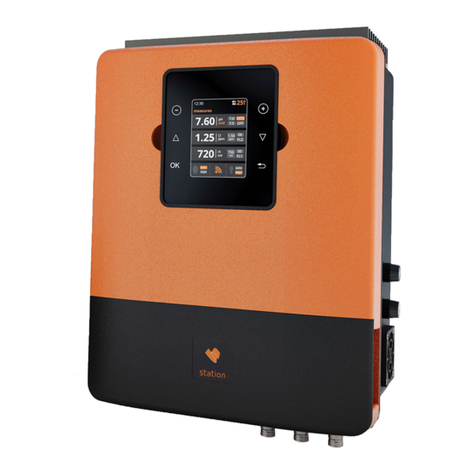
sugar-valley
sugar-valley Vistapool installation guide

Aqua Logic
Aqua Logic AquaMate Installation & setup instructions

BJ Live
BJ Live Participation box user guide

HySecurity
HySecurity StrongArmPark DC 10 Programming and operations manual
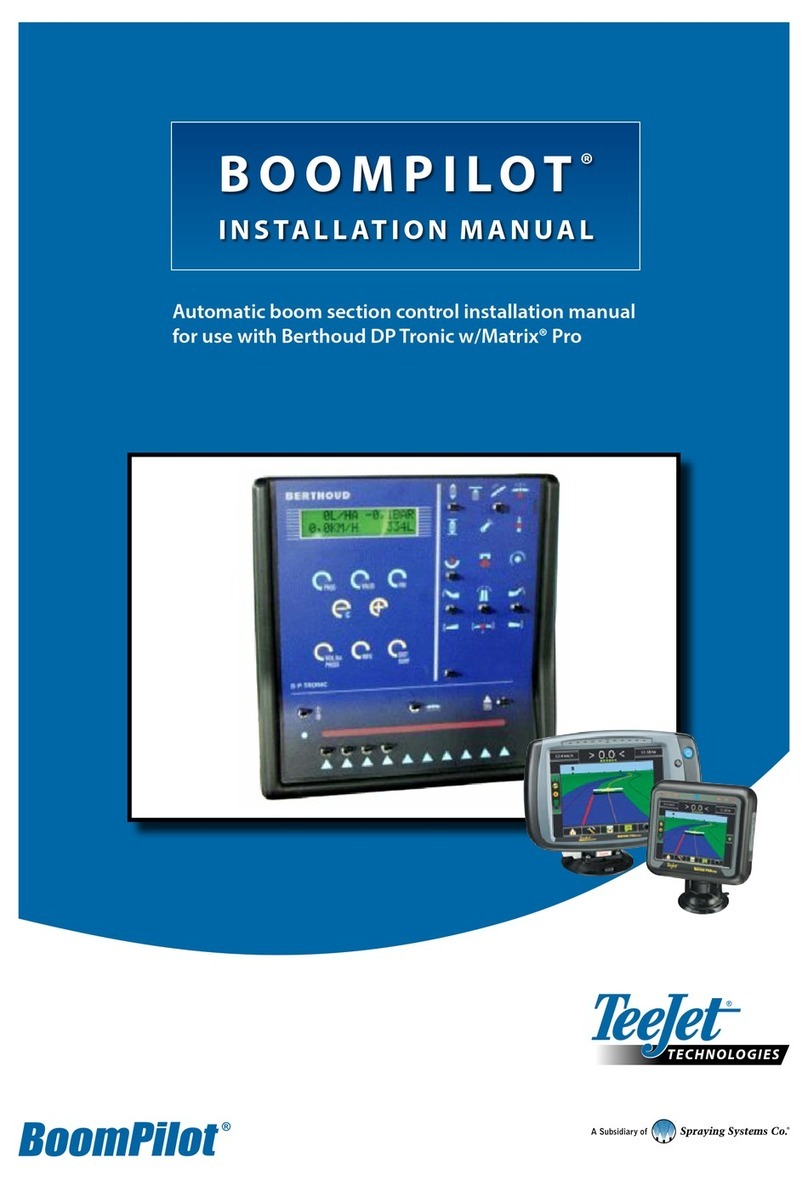
Spraying Systems
Spraying Systems TeeJet TECHNOLOGIES BoomPilot installation manual
